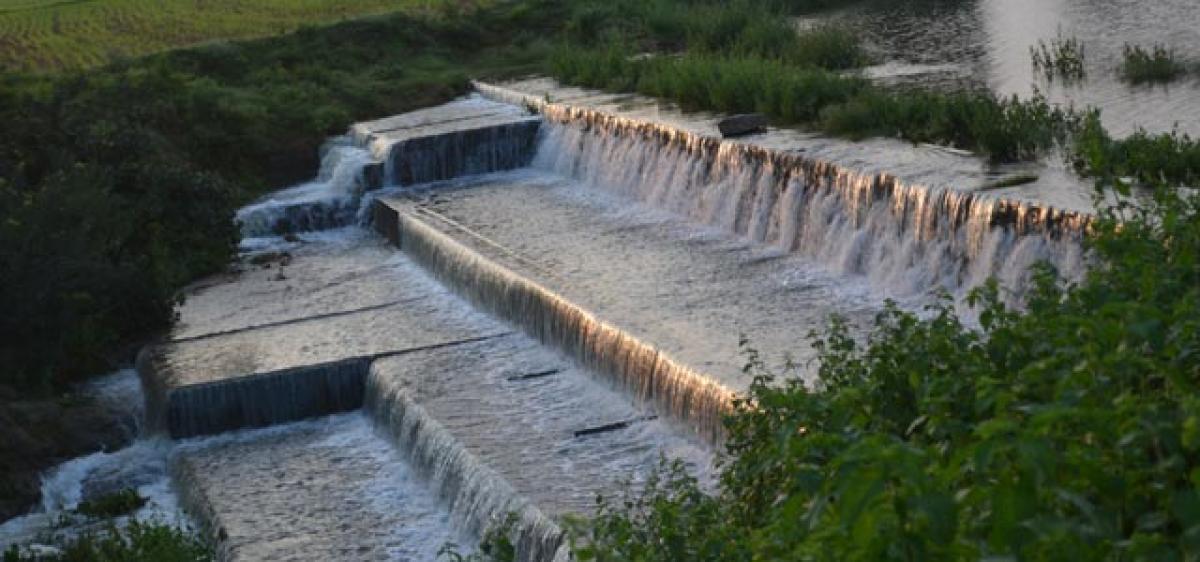Live
- DEO suspends teacher accused of sexual assault
- PM ‘cursing’ Congress out of despair: Maharashtra Cong Chief
- Applications are invited for Junior Colleges Scheme District Scheduled Castes Development Officer Ramlal
- A nomination was filed on the second day for the Nagar Kurnool parliamentary seat
- SP Gaikwad inspected the Telangana Amarnath Saleswaram Jatara yatra arrangements
- Rahul Gandhi's decision to contest from Wayanad shows 'lack of confidence': BJP President Nadda
- IPL 2024: Delhi bowlers will go after all of SRH’s top-order batters, says head coach Ricky Ponting
- At Amroha rally, PM Modi sends out ‘meaningful’ message for Muslims and Hindus
- Tripura records highest 79.83 pc voter turnout in Northeast
- The government has to clear the confusion
Just In

September rains had brought respite to farmers affected by successive years of drought in highly drought-prone Chinnakodur mandal in Siddipet district.
Chinnakodur (Siddipet): September rains had brought respite to farmers affected by successive years of drought in highly drought-prone Chinnakodur mandal in Siddipet district. As the irrigation tanks were overflowing, filling one water body after the other due to the connected way in which they were designed centuries ago by the Kakatiyas and the Nizams, farmers thought the abundance of water would have brought to an end all their problems.
Ruling party leaders were quick enough pat themselves on their backs for implementing Mission Kakatiya which they thought was the reason for smiles in the faces of farmers. However, in at least three villages in Chinnakodur mandal, faulty Mission Kakatiya works have left irrigation tanks drying rapidly, even as the farmers in those villages are crying - just imagining yet another year of drought even though there were good rains last year.
Jalu Cheruvu (also called Allipur cheruvu) has been the lifeline for Allipur and Mylaram gram panchayats ever since it was built to be a percolation tank. Though there was an ayacut of hundreds of acres in Allipur village limits long ago, irrigating the fields to their last mile, over the decades the canals ended up being blocked and covered. It continued to act as a percolation tank, raising the groundwater levels in Allipur and Kammarlapally villages under whose limits it is located.
Water is available in open wells and agricultural bore-wells only if there is water availability in Jalu cheruvu. Under Mission Kakatiya Phase- I, desilting, bund strengthening and other works were undertaken in these two water bodies. It is an open secret that local politicians had managed to get contracts for the works. According to the villagers, the ZPTC’s husband was the one who did the works.
The result of a blunder which was made while desilting Jalu cheruvu in 2014 could be seen today. As the contractor kept making pits a little too deep very close to the bund, the sub-strata of the water bed got exposed, rendering the soil permeable, allowing water to seep into the ground as they breached the bund from underneath it, flowing out of the percolation tank. Result was that within just a couple of months what was a tank fully brimming with water has now become almost empty.
Only water contained inside the deep pits dug during MK Phase-I works is left. That too is expected to get dry within a couple of months, if not within days. Not only in Jalu cheruvu, similar blunder was done while desilting Karnala Kunta too, which has met with a similar fate. Agricultural crops in Allipur village were damaged due to submersion when Jalu Cheruvu was full during Kharif 2016. In Kharif 2017, the villagers of Allipur, Kammarlapally and Mylaram villages face horrifying prospects of another drought year - thanks to the work of the contractor.
“Wells have already started drying-up. It is difficult to imagine what we may have to go through this summer,” said Yellaiah, a worried farmer in Kammarlapally. Officials of the Irrigation Department feel that the problem could have been easily avoided if the villagers and people’s representatives including the contractor had communicated to them regarding the possible breach of bund this way, when the works were being undertaken.
They do have an immediate solution. By digging deep trenches near the bund, filling BC soil and rolling it through a process called ‘positive cut-off,’ seepage of water and breaching of bund could be prevented. For this, they say the entire tank needs to go dry first.Ravinder Reddy, Executive Engineer, Irrigation Department, Siddipet, spoke to The Hans India at length regarding the problem and assured that positive cut-off would be done this summer, so that in the coming rainy season this doesn’t get repeated again.
He also explained how successive years of drought may lead to a situation in drought-prone areas like Chinnakodur, where water from the abundant rains would first replenish the already depleted ground water levels before reaching saturation. This could also be a reason for irrigation tanks going empty even after good rains, according to him. However, he did agree that over desilting to the point of exposing the sub-strata could cause water to flow out of the tank. He also assured that the department would make the contractor undertake the positive cut-off work.
By Vivek Bhoomi

© 2024 Hyderabad Media House Limited/The Hans India. All rights reserved. Powered by hocalwire.com







